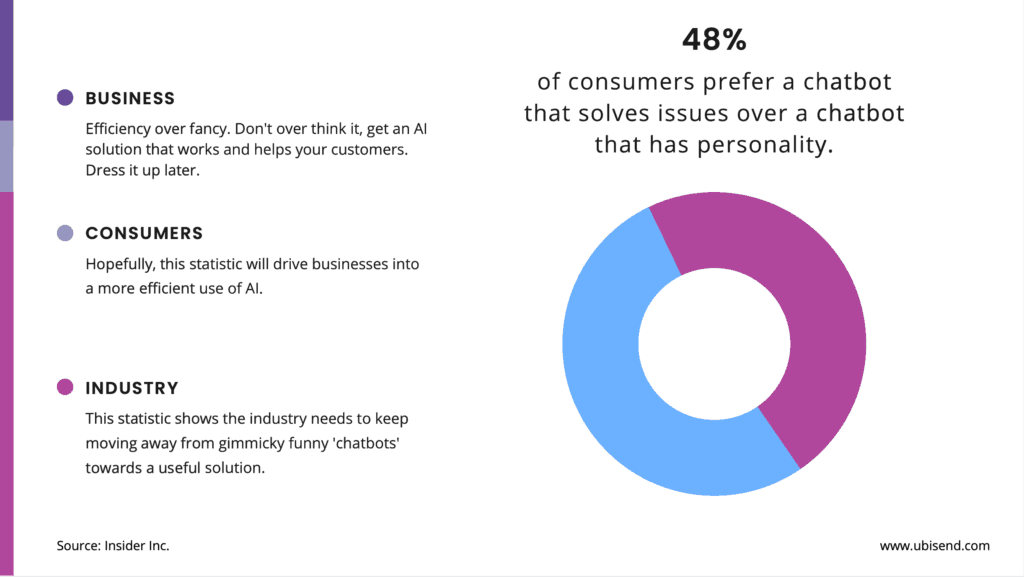Globalization and broad access to the Internet changed the way we do business in the modern age.
These two elements brought speedy communication (even when the participants are continents apart) and the possibility for almost anyone to extend in new markets all over the world.
But there are other factors that help transform the face of business. With cheaper hardware that is constantly upgraded, devices that get smaller and more powerful, and highly intelligent systems, businesses have the possibility to eliminate costs and improve.
Furthermore, due to smart technologies like chatbots, businesses can now provide round-the-clock service assistance in areas like banking, wellness, e-commerce, real estate, finance, or health.
According to Gartner, the trend is towards AI and ML integration in building better customer experience. They predict that 47% of organizations will use chatbots for customer services and around 40% will choose to use virtual assistants for routine tasks.
As these technologies get better at communicating naturally, organizations will be able to cut costs with call centres or personnel trapped in menial jobs.
We already experience chatbots on platforms like Facebook Messenger, Slack, or WhatsApp as messenger assistants that can answer specific questions or guide the audience.
These chatbots personalize the experience for customers and allow businesses to target their message without raising costs.
Table of Contents
How are Chatbots Perceived by the Public?
The rise of chatbots is directly linked to the way we communicate with each other while using devices.
As such, as the available meanings of communications developed, humans showed a preference for messaging.
From Instant Chat Messenger boards (like the one developed by Yahoo!) to Facebook Messenger and WhatsApp, we now use this form of communication in our daily interactions.
Even more, people use messaging to communicate with businesses via in-browser chat apps that help them register a complaint, get in touch with a specific person within the organization, or learn more about new features.
But what most people who interact using chat apps don’t know is that, more often than not, there isn’t a real person at the other end of the conversation.

Due to the recent development of AI and ML, we now have intelligent chatbots that can understand natural speech and can reply in a friendly, human-like manner.
In addition, some algorithms can recognize voices and understand natural language, which led to the creation of virtual assistants (Siri, Alexa, or Google Assistant).
But how does that integrate with the public? Are people willing to speak with chatbots emulating a human being instead of a real person?
As it turns out, 40% of people don’t care if they’re helped by a chatbot or a real human. As long as they get the information they’re looking for in the fastest possible manner, how they get it is irrelevant.
In fact, some people may actually prefer this type of interaction when they call their bank or other services that usually have long waiting times.
Lastly, according to developers, people can get quite personal with chatbots, to the point where they actually address the bot as if they would another person (while fully knowing they are talking to an app).
Are All Chatbots Smart?
A chatbot app or a virtual assistant is only as smart as the algorithm that powers it. As such, not all apps are created equally because they are not to be used in the same way.
Some apps are only programmed to recognize keywords and offer details based on a simple ‘If-Then-Else’ system. You may find them on small e-commerce sites and their job is to gather information (such as email addresses) and offer some advice based on keyword research.
It’s also safe to say that this branch of the industry is not likely to withstand the test of time since it can’t be further developed or improved.The chatbots that set a trend and are likely to become a part of our daily lives as consumers and business owners are the ones powered by AI and ML.
Their job is to learn from customers’ behaviour and recognize patterns based on the collected data in order to emulate natural speech and reply in a manner that’s friendly and welcoming.
Of course, this doesn’t mean you’ll have to learn Machine Learning or Artificial Intelligence to understand how to integrate them into your business. However, it is helpful to be up to date with the latest developments, since technology is evolving at an extremely fast pace.
The Benefits of Using Chatbots in Businesses

While many businesses (big or small) consider integrating intelligent customer service systems in their activities, there are some that remain skeptical. Besides the fear of investing in a system that may not rise up to the hype, there’s also the fear that this may be a passing trend.
First, according to Opus Research, we should see around $4.5 billion invested in chatbots by 2021. This means that the technology is here to stay and that we will see more of it being used by organizations worldwide.
Second, while chatbot systems are already highly effective, developers are constantly working on creating better algorithms that will eventually be capable of sustaining a natural conversation and performing complex activities.
Until then, here are some of the most important benefits for businesses that use chatbots as they are right now:
- Cutting costs – most chatbots are employed to help customers with simple questions and recommendations that can be boring and repetitive to a human agent. Even more, a chatbot is available 24/7 and reduces the human error associated with boredom or fatigue. As a result, the service will be more efficient and companies get to cut costs with personnel.
- Speedy response times – human agents need time to search and find the information required by a customer. However, an AI-based algorithm can find and retrieve the data in a matter of seconds, thus reducing waiting times.
- Increase in income – chatbots can be used to create a personalized online experience for each customer that interacts with your brand. Furthermore, these systems can be implemented in social media channels, which are preferred by customers. According to a recent study, customers spend 20-40% more with companies that engage and respond via social media
- Increased lead generation – conversational bots can be used to start a discussion with visitors who are just poking around. They can also guide undecided customers through the sales funnel, offering recommendations and keeping the discussion interesting. Lastly, these bots can be trained to get email addresses and increase the list of leads.
- Better retention rate – customers like to feel they are important for your brand, but this requires a huge effort, especially when the brand is well-known. Luckily, AI-trained bots can keep up with the task and learn the patterns and preferences of each customer. This way, you can personalize the shopping experience and keep in touch by sending customized product/service recommendations.
The list of benefits for businesses could go on, but we should take a look at the other side as well. Is the chatbot industry helping developers in any way?
As it turns out, the market is expected to reach 9.4 billion by 2024, especially for the retail and e-commerce industries. The focus will be set on developing intelligent bots that can process natural language and work with deep learning models and algorithms, which can open the road to new ideas.
For now, anyone interested in working with chatbots should consider getting a TensorFlow certification and focus on AI and ML systems. The future of technology is all about intelligent machines that can help reduce the number of menial jobs for humans.
Are Intelligent Chatbots the End of Call Centers?
For the last decade, the call centre industry ballooned up on a global level. The market is well set on almost all continents, with Europe taking the lead in 2017 (around 50 billion U.S. dollars in revenue) followed by North America (45 billion U.S. dollars) and Latin America (20 billion U.S. dollars in revenue).
Until recently, when you thought of call centres you used to imagine a bunch of cubicles, filled with people taking on calls. However, with the development of chatbots, virtual assistants, messaging, and other new technologies, the face of call centres is starting to change.
We now have bots that can conduct conversations and handle requests without human involvement. Does this mean we won’t need people on the phone anymore?
Running a quick comparison, we learn that chatbots don’t get tired even when they work full-time, 24/7 and they don’t ask for leave or salaries. In addition, a bot can handle multiple lines of business in several languages without error.
So why do still businesses use call centres with human operators?
As it turns out, chatbots can’t (yet) handle more complex operations and requests. So, call centres work in a transitional phase where AI-powered apps and systems handle routine tasks, while human operators supervise and focus on tasks that require creativity and brain-power.
For now, the call centre industry is not at risk, but the future may change quite quickly.
Businesses Where Chatbots Thrive
According to Accenture’s report, these are the industries that find chatbots extremely useful and are open to the idea of a full integration:
Message-based assistants (aka chatbots):
- Healthcare (64%),
- Telecommunications (59%)
- Banking (50%)
- Customer service (95%)
- Sales and marketing (55%)
- Order processing (48%)
Voice assistants:
- Food (56%),
- Banking (44%),
- And retail (35%)
The most common example is the use of virtual assistants. People can now talk (naturally) to their smartphones or smart speakers and ask them to do all sorts of things like playing a specific song, performing an online search, offering information on weather, book appointments, and more.
But intelligent AI systems that can take care of customer service are now available in all sorts of areas. For instance, some governmental institutions use chatbots to notify locals about upcoming events, holiday activities, or changes in local regulations. But there are also chatbots designed to offer touristic recommendations, accurate information on available healthcare, and more.
E-commerce is another area where customers are more likely to encounter a chatbot app. Most online retailers (from new e-commerce businesses to huge brands) have a virtual assistant readily available so customers can ask questions and ask recommendations. In addition, these systems are designed to personalize each experience and guide possible buyers through the sales funnel.
The banking system is quite fond of chatbots because they are available 24/7 and can help customers perform a wide array of small tasks such as checking their account, making transfers, asking about various systems, or making transactions. As a result, the customer service segment is faster, more efficient, and costs less.
Is Your Business Ready to Use Chatbots?
While the world of chatbots is fascinating, we can’t help but wonder whether or not it applies to the regular SMB (small and mid-sized business). So, we did a quick comparison and came up with a few pros and cons to keep in mind when you’re thinking about using bots.
The Pros
At first glance, it can be impressive to think about automation integration. For instance, e-commerce platforms and retailers get a lot of use from customer support bots that already exist on established platforms (like the one supplied within Facebook Messenger, Slack, or WhatsApp).
These bots can guide customers through the sales funnel, take orders, facilitate transactions, and answer basic questions. They can also make sure to get valuable information from customers who don’t feel like filling out a form by striking a conversation with them and trying to convince them to submit their email address for future communications.
In summary, even basic bots can drive an increase in quality leads, generate more sales, and increase customer satisfaction by personalizing the experience.
The Cons
The efficiency of automation integration is highly dependent on the industry in which you are activating. As such, it can be tricky for small players who don’t have that much customer interaction, to begin with. In addition, the integration and maintenance costs may not make sense for a small business when compared with the costs of having a human agent.
Lastly, if the automation is not designed to enhance the customer experience, this can deter people from reaching out. If you ever called your bank/local government agency and had to go through several layers of automation (questions delivered by a bot) before you could reach a real person, it’s easy to understand why people could get frustrated.
In summary, SMBs run the risk of investing in a system that could be rejected by the target audience.
Wrap Up
The chatbots industry is not just a trend – it’s a new direction many businesses and organizations will take in order to improve customer service experience and reduce costs.
However, the current technology is not for everyone. As such, before you consider automation implementation in your business, make sure it is a good fit for your needs.
 Monetize.info We Help You Grow & Monetize Your Online Business!
Monetize.info We Help You Grow & Monetize Your Online Business!

![How Do Consumers Feel About Chatbots And What Does It Mean For Your Business? [Recent Research Data Included]](https://monetize.info/wp-content/uploads/2020/02/How-Do-Consumers-Feel-About-Chatbots-And-What-Does-It-Mean-For-Your-Business-Recent-Research-Data-Included.webp)



![10 Ways To Find a Buyer for Your Online Business [With Examples]](https://monetize.info/wp-content/uploads/2024/04/10-Ways-To-Find-a-Buyer-for-Your-Online-Business-With-Examples-310x165.webp)

